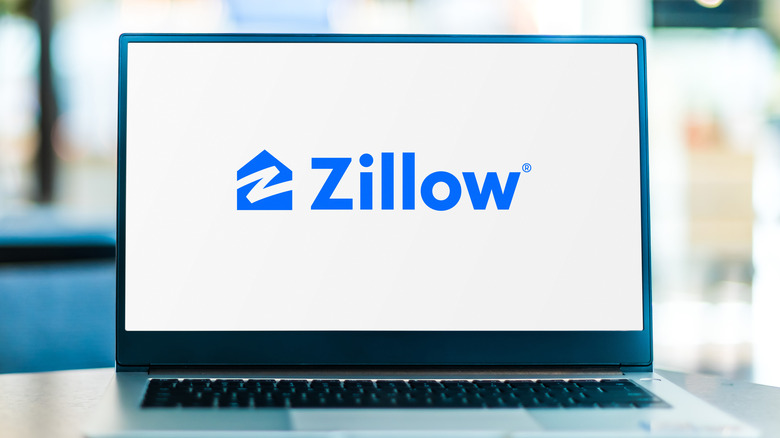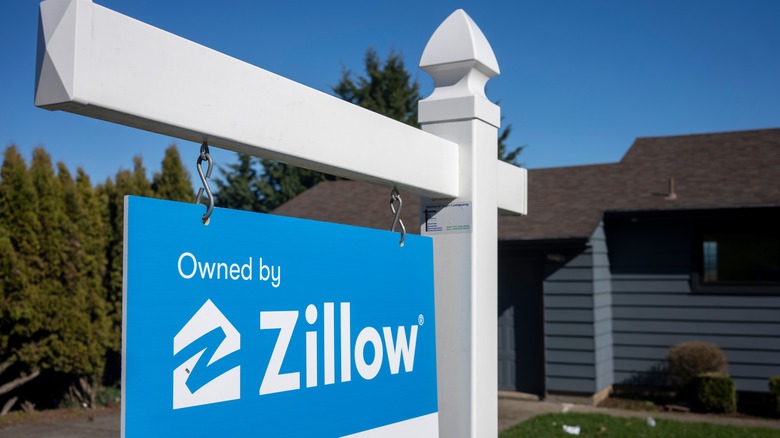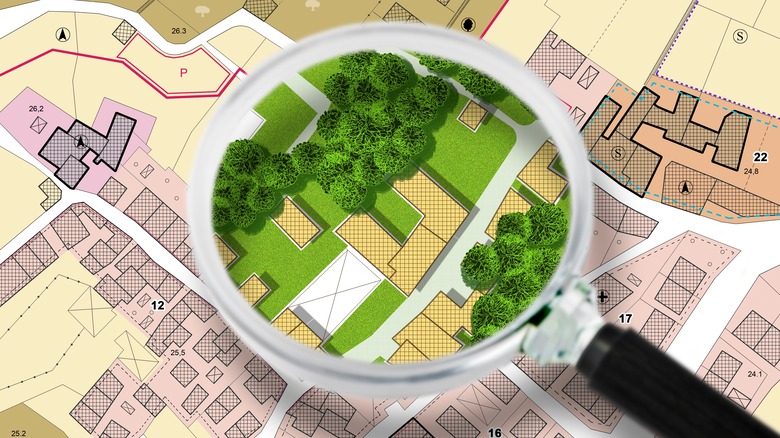5 Things To Keep In Mind When Looking For A Home On Zillow
Zillow has become the preeminent search destination for those looking to purchase a new home. Even after Zillow's painful return to reality in 2021 that led the company to exit the market as a direct reseller of homes and layoff thousands of employees, according to Inside Big Data, the brand remains an essential name in the effort to buy or sell a home on the real estate market. Ruby Home reports that Zillow hosts roughly 68 million searchers every month, dwarfing the competition in this space. You can even search for rental properties on Zillow's site and app these days.
When searching for a new home on Zillow, you may be faced with a huge variety of choices and a general feeling of ambiguity when it comes to finding exactly what you're looking for. This is natural in the home buying process, and it certainly isn't limited only to Zillow's site, which supports 135 million listings (via iProperty Management). Zillow can't tell you everything about a home, but it can certainly help in your efforts.
With these helpful tips in mind, navigating the Zillow marketplace and finding properties that match your search criteria and geographical needs doesn't have to be a complex and infuriating endeavor. Continue reading to learn about five key things to keep in mind when you're searching for your next home using the Zillow platform.
Inclusions in photos and walkthrough videos can be illuminating
When searching for any new home, one important feature of the online part of your process lies in the pictures. Browsing through pictures can help you get a sense of the layout of a property and any included amenities that the space boasts. This is an important part of searching for your next home because these features and design elements will play a central role in whether the property suits your needs. Zillow reports that a typical listing should include 22 to 27 pictures, and it's important to note that when staging a property and snapping images, a homeowner likely took hundreds of pictures and has selected the best ones for their listing.
On the one hand, six different pictures of the same room give a homeowner the ability to select one that incorporates the widest angle or the best vantage point for understanding what's in the space. However, it also allows a seller the leeway to select the picture that best hides some negative aspects that may be lurking in the room as well. Browsing through pictures of homes that you're interested in is an important part of your search, but maintaining a critical eye for detail about what's included and what seems to have been overlooked or minimized in the available pictures can help you immensely when deciding what homes to go view and which ones to pass on.
The Zestimate should be taken with a huge grain of salt
One unique feature of the Zillow platform is that all properties listed for sale are equipped with a Zillow estimate of the home's fair price, or its "Zestimate." The Zestimate is designed to help buyers and sellers understand the nuances of their local marketplace with greater clarity and without having to do a heap of research themselves. This estimate takes into account recent sales in the area, prior listings of similar size or home makeup, and much more. The Zestimate seeks to aggregate a large volume of data in order to produce a clear understanding of what a home's value might be (via Investopedia). But all manner of market features can change the value of a property.
The estimate should be used as a signpost rather than a gospel. Home By School notes that the margin of error on this figure for Fairfax, Virginia, sits around 7%, while Dave Hook Real Estate reports that this can rise to as much as 20% in some areas. This makes it a terrible indicator of what a property might actually sell for.
It's also worth noting that some sellers might see an estimated figure provided by Zillow and get this number stuck in their heads. It may be difficult to negotiate with a seller who has already made up their mind that they won't sell the property for less than this estimate, even if Zillow has overvalued the property.
A home's DOM number can be reset on Zillow
It's worth noting that the number of days on the market is an important metric for judging the staleness of a listing. The St. Louis Federal Reserve Bank reports that the average days on the market figure in 2022 has fluctuated between a high of 62 days (in January) and a low of 31 days (in May). This corresponds roughly with House Digest's own recommendations for when to list a home. Buyers may begin to get a little queasy about viewing properties that have surpassed this number because it can be easy to mentally correlate a high DOM figure with some kind of inherent flaw in the property. This isn't always the case, of course, but it doesn't stop buyers from developing weariness surrounding older or stale listings.
Because of this trait, it's important to know that a home's DOM can be reset on Zillow. If a seller removes their listing for more than 30 days, its DOM figure will reset when they relist the property. This practice can bring freshness to a buyer's sentiment surrounding the property, so it's worth investigating whether a home you're interested in has been listed only once or multiple times in an effort to reduce its DOM. Some sellers also opt to market their property as a for-sale-by-owner listing on Zillow. After a time, they might remove the property and relist it in the traditional way to reset the DOM.
Consider for sale by owner properties, too
A for-sale-by-owner listing shouldn't be excluded from your search parameters. There's nothing inherently wrong with this type of property, and a homeowner marketing their property this way might actually be beneficial to you as a Zillow searcher.
The way Zillow handles for-sale-by-owner listings isn't very beneficial to the seller, even as it remains a quality option for these types of listings. If you're willing to consider these properties, then you might be able to take advantage of far less competition for a great home that meets all of your needs. FSBO properties are segmented out from the typical listings that are added by real estate agents, so they are harder to find (via Real Estate Witch). As a result, they may not come up organically as you enter search parameters. Many buyers simply overlook these additional listings as they browse the results, but taking the time to scour through FSBO properties can help you find a potential diamond in the rough that buyers might otherwise overlook.
If you do come across a property that matches your needs, then you may also have better leverage when negotiating. Because of depressed competition and a lack of incentive for real estate agents to showcase these properties to prospective buyers, you may be the only one approaching the seller on a listing that may have existed for weeks or even months without much interest at all.
You can generate custom search areas to exclude unwanted geographies
Zillow also allows for custom search parameters that include drawn geographies (via Zillow Group). Not only can you exclude homes that don't have the right number of bedrooms, square footage, or garage space to support your car storage or workshop needs, but you can also draw a custom search area on the Zillow map. This gives you the ability to narrow your focus and eliminate additional results that may match some of your needs but don't provide a crucial element when it comes to proximity to work or school for you and your family.
Location is an essential asset in the home search. This is essentially the one thing that you can't change about a home, so you need to ensure that the positioning of a property relative to the amenities and destinations that you travel to and rely on makes sense for you and your loved ones. With the custom map feature offered by Zillow, you can ensure that you aren't wasting your time by considering a property that turns out to be 25 miles down the road from where you want to live.





